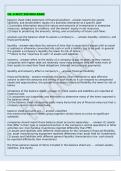Exam (elaborations)
Ch. 4 ACCT 300 WKU
- Course
- Institution
balance sheet (AKA statement of financial position) - answer-reports the assets, liabilities, and stockholders' equity of a business enterprise at a specific date (1) provides information about the nature and amounts of investments in enterprise resources, obligations to creditors, and the owners'...
[Show more]



